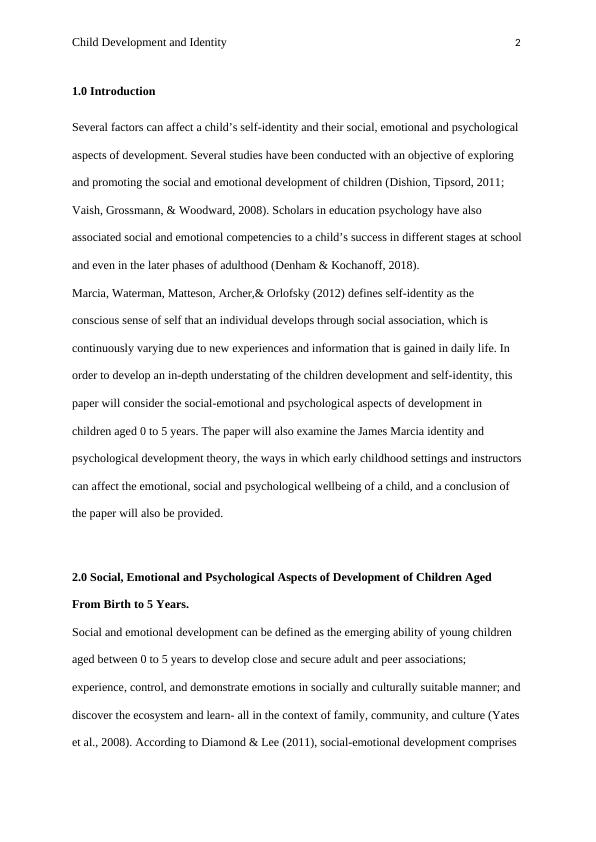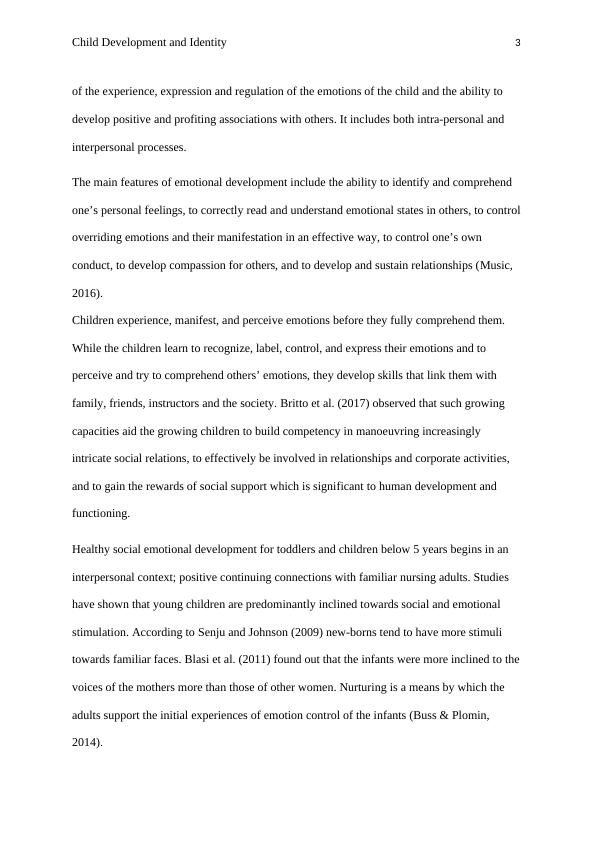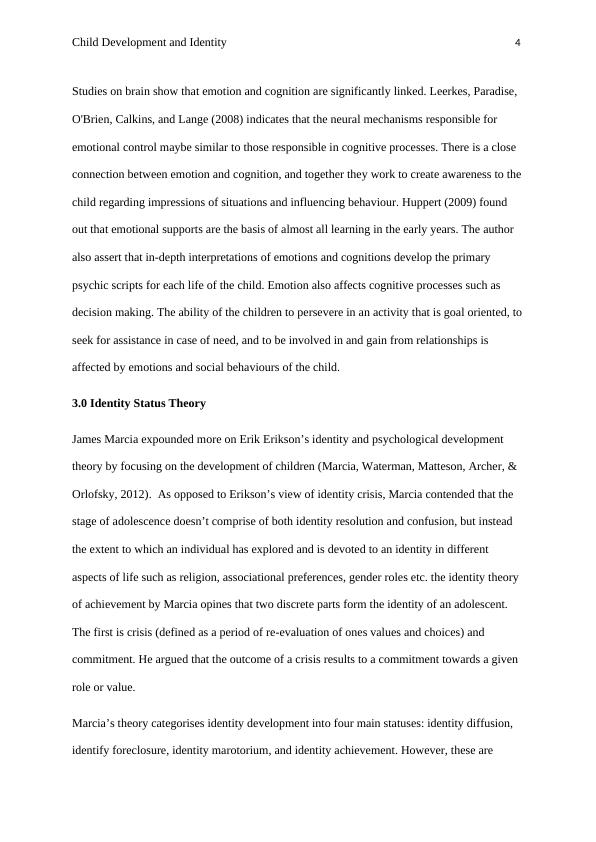Factors Influencing Child Development and Identity
11 Pages3077 Words219 Views
Added on 2023-06-07
About This Document
This paper explores the social, emotional and psychological aspects of development in children aged 0 to 5 years, the James Marcia identity and psychological development theory, and the effects of early childhood settings and educators on children’s social, emotional, and psychological wellbeing.
Factors Influencing Child Development and Identity
Added on 2023-06-07
ShareRelated Documents
Running head: Child Development and Identity 1
Factors Influencing Child Development and Identity
By:
Student ID:
Course No:
Tutor:
Date:
Factors Influencing Child Development and Identity
By:
Student ID:
Course No:
Tutor:
Date:

Child Development and Identity 2
1.0 Introduction
Several factors can affect a child’s self-identity and their social, emotional and psychological
aspects of development. Several studies have been conducted with an objective of exploring
and promoting the social and emotional development of children (Dishion, Tipsord, 2011;
Vaish, Grossmann, & Woodward, 2008). Scholars in education psychology have also
associated social and emotional competencies to a child’s success in different stages at school
and even in the later phases of adulthood (Denham & Kochanoff, 2018).
Marcia, Waterman, Matteson, Archer,& Orlofsky (2012) defines self-identity as the
conscious sense of self that an individual develops through social association, which is
continuously varying due to new experiences and information that is gained in daily life. In
order to develop an in-depth understating of the children development and self-identity, this
paper will consider the social-emotional and psychological aspects of development in
children aged 0 to 5 years. The paper will also examine the James Marcia identity and
psychological development theory, the ways in which early childhood settings and instructors
can affect the emotional, social and psychological wellbeing of a child, and a conclusion of
the paper will also be provided.
2.0 Social, Emotional and Psychological Aspects of Development of Children Aged
From Birth to 5 Years.
Social and emotional development can be defined as the emerging ability of young children
aged between 0 to 5 years to develop close and secure adult and peer associations;
experience, control, and demonstrate emotions in socially and culturally suitable manner; and
discover the ecosystem and learn- all in the context of family, community, and culture (Yates
et al., 2008). According to Diamond & Lee (2011), social-emotional development comprises
1.0 Introduction
Several factors can affect a child’s self-identity and their social, emotional and psychological
aspects of development. Several studies have been conducted with an objective of exploring
and promoting the social and emotional development of children (Dishion, Tipsord, 2011;
Vaish, Grossmann, & Woodward, 2008). Scholars in education psychology have also
associated social and emotional competencies to a child’s success in different stages at school
and even in the later phases of adulthood (Denham & Kochanoff, 2018).
Marcia, Waterman, Matteson, Archer,& Orlofsky (2012) defines self-identity as the
conscious sense of self that an individual develops through social association, which is
continuously varying due to new experiences and information that is gained in daily life. In
order to develop an in-depth understating of the children development and self-identity, this
paper will consider the social-emotional and psychological aspects of development in
children aged 0 to 5 years. The paper will also examine the James Marcia identity and
psychological development theory, the ways in which early childhood settings and instructors
can affect the emotional, social and psychological wellbeing of a child, and a conclusion of
the paper will also be provided.
2.0 Social, Emotional and Psychological Aspects of Development of Children Aged
From Birth to 5 Years.
Social and emotional development can be defined as the emerging ability of young children
aged between 0 to 5 years to develop close and secure adult and peer associations;
experience, control, and demonstrate emotions in socially and culturally suitable manner; and
discover the ecosystem and learn- all in the context of family, community, and culture (Yates
et al., 2008). According to Diamond & Lee (2011), social-emotional development comprises

Child Development and Identity 3
of the experience, expression and regulation of the emotions of the child and the ability to
develop positive and profiting associations with others. It includes both intra-personal and
interpersonal processes.
The main features of emotional development include the ability to identify and comprehend
one’s personal feelings, to correctly read and understand emotional states in others, to control
overriding emotions and their manifestation in an effective way, to control one’s own
conduct, to develop compassion for others, and to develop and sustain relationships (Music,
2016).
Children experience, manifest, and perceive emotions before they fully comprehend them.
While the children learn to recognize, label, control, and express their emotions and to
perceive and try to comprehend others’ emotions, they develop skills that link them with
family, friends, instructors and the society. Britto et al. (2017) observed that such growing
capacities aid the growing children to build competency in manoeuvring increasingly
intricate social relations, to effectively be involved in relationships and corporate activities,
and to gain the rewards of social support which is significant to human development and
functioning.
Healthy social emotional development for toddlers and children below 5 years begins in an
interpersonal context; positive continuing connections with familiar nursing adults. Studies
have shown that young children are predominantly inclined towards social and emotional
stimulation. According to Senju and Johnson (2009) new-borns tend to have more stimuli
towards familiar faces. Blasi et al. (2011) found out that the infants were more inclined to the
voices of the mothers more than those of other women. Nurturing is a means by which the
adults support the initial experiences of emotion control of the infants (Buss & Plomin,
2014).
of the experience, expression and regulation of the emotions of the child and the ability to
develop positive and profiting associations with others. It includes both intra-personal and
interpersonal processes.
The main features of emotional development include the ability to identify and comprehend
one’s personal feelings, to correctly read and understand emotional states in others, to control
overriding emotions and their manifestation in an effective way, to control one’s own
conduct, to develop compassion for others, and to develop and sustain relationships (Music,
2016).
Children experience, manifest, and perceive emotions before they fully comprehend them.
While the children learn to recognize, label, control, and express their emotions and to
perceive and try to comprehend others’ emotions, they develop skills that link them with
family, friends, instructors and the society. Britto et al. (2017) observed that such growing
capacities aid the growing children to build competency in manoeuvring increasingly
intricate social relations, to effectively be involved in relationships and corporate activities,
and to gain the rewards of social support which is significant to human development and
functioning.
Healthy social emotional development for toddlers and children below 5 years begins in an
interpersonal context; positive continuing connections with familiar nursing adults. Studies
have shown that young children are predominantly inclined towards social and emotional
stimulation. According to Senju and Johnson (2009) new-borns tend to have more stimuli
towards familiar faces. Blasi et al. (2011) found out that the infants were more inclined to the
voices of the mothers more than those of other women. Nurturing is a means by which the
adults support the initial experiences of emotion control of the infants (Buss & Plomin,
2014).

Child Development and Identity 4
Studies on brain show that emotion and cognition are significantly linked. Leerkes, Paradise,
O'Brien, Calkins, and Lange (2008) indicates that the neural mechanisms responsible for
emotional control maybe similar to those responsible in cognitive processes. There is a close
connection between emotion and cognition, and together they work to create awareness to the
child regarding impressions of situations and influencing behaviour. Huppert (2009) found
out that emotional supports are the basis of almost all learning in the early years. The author
also assert that in-depth interpretations of emotions and cognitions develop the primary
psychic scripts for each life of the child. Emotion also affects cognitive processes such as
decision making. The ability of the children to persevere in an activity that is goal oriented, to
seek for assistance in case of need, and to be involved in and gain from relationships is
affected by emotions and social behaviours of the child.
3.0 Identity Status Theory
James Marcia expounded more on Erik Erikson’s identity and psychological development
theory by focusing on the development of children (Marcia, Waterman, Matteson, Archer, &
Orlofsky, 2012). As opposed to Erikson’s view of identity crisis, Marcia contended that the
stage of adolescence doesn’t comprise of both identity resolution and confusion, but instead
the extent to which an individual has explored and is devoted to an identity in different
aspects of life such as religion, associational preferences, gender roles etc. the identity theory
of achievement by Marcia opines that two discrete parts form the identity of an adolescent.
The first is crisis (defined as a period of re-evaluation of ones values and choices) and
commitment. He argued that the outcome of a crisis results to a commitment towards a given
role or value.
Marcia’s theory categorises identity development into four main statuses: identity diffusion,
identify foreclosure, identity marotorium, and identity achievement. However, these are
Studies on brain show that emotion and cognition are significantly linked. Leerkes, Paradise,
O'Brien, Calkins, and Lange (2008) indicates that the neural mechanisms responsible for
emotional control maybe similar to those responsible in cognitive processes. There is a close
connection between emotion and cognition, and together they work to create awareness to the
child regarding impressions of situations and influencing behaviour. Huppert (2009) found
out that emotional supports are the basis of almost all learning in the early years. The author
also assert that in-depth interpretations of emotions and cognitions develop the primary
psychic scripts for each life of the child. Emotion also affects cognitive processes such as
decision making. The ability of the children to persevere in an activity that is goal oriented, to
seek for assistance in case of need, and to be involved in and gain from relationships is
affected by emotions and social behaviours of the child.
3.0 Identity Status Theory
James Marcia expounded more on Erik Erikson’s identity and psychological development
theory by focusing on the development of children (Marcia, Waterman, Matteson, Archer, &
Orlofsky, 2012). As opposed to Erikson’s view of identity crisis, Marcia contended that the
stage of adolescence doesn’t comprise of both identity resolution and confusion, but instead
the extent to which an individual has explored and is devoted to an identity in different
aspects of life such as religion, associational preferences, gender roles etc. the identity theory
of achievement by Marcia opines that two discrete parts form the identity of an adolescent.
The first is crisis (defined as a period of re-evaluation of ones values and choices) and
commitment. He argued that the outcome of a crisis results to a commitment towards a given
role or value.
Marcia’s theory categorises identity development into four main statuses: identity diffusion,
identify foreclosure, identity marotorium, and identity achievement. However, these are

End of preview
Want to access all the pages? Upload your documents or become a member.
Related Documents
Children’s Social, Emotional And Psychological Well-Beinglg...
|10
|2469
|404
ECCDD103A Management Report 2022lg...
|9
|2417
|18
Social, Psychological, and Emotional Aspects of Child Developmentlg...
|9
|3262
|245
Early Childhood Developmentlg...
|10
|2957
|413
Growth and Developmentlg...
|12
|1225
|472
Children’s Self-Identity and Family Contextslg...
|11
|2923
|451
